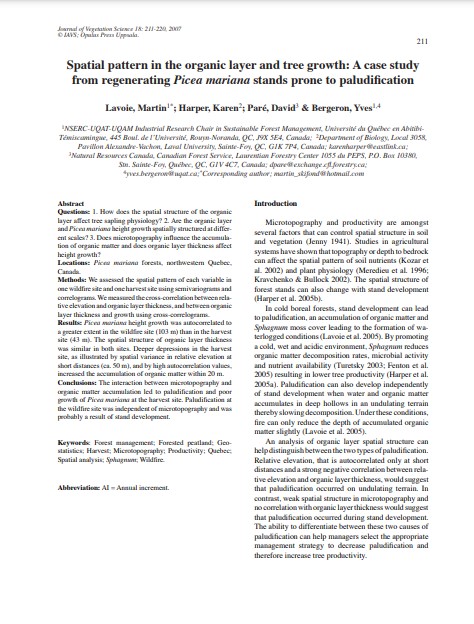Spatial pattern in the organic layer and tree growth: A case study from regenerating Picea mariana stands prone to paludification
Bosque Modelo:
Lake Abitibi
Temática:
Restauración
Tipo de documento:
Artículo científico
Resumen
Questions: 1. How does the spatial structure of the organic layer affect tree sapling physiology? 2. Are the organic layer and Picea mariana height growth spatially structured at different scales? 3. Does microtopography influence the accumulation of organic matter and does organic layer thickness affect height growth?
Locations: Picea mariana forests, northwestern Quebec, Canada.
Methods: We assessed the spatial pattern of each variable in one wildfire site and one harvest site using semivariograms and correlograms. We measured the cross correlation between relative elevation and organic layer thickness, and between organic layer thickness and growth using cross-correlograms.
Results: Picea mariana height growth was autocorrelated to a greater extent in the wildfire site (103 m) than in the harvest site (43 m). The spatial structure of organic layer thickness was similar in both sites. Deeper depressions in the harvest site, as illustrated by spatial variance in relative elevation at short distances (ca. 50 m), and by high autocorrelation values, increased the accumulation of organic matter within 20 m.
Conclusions: The interaction between microtopography and organic matter accumulation led to paludification and poor growth of Picea mariana at the harvest site. Paludification at the wildfire site was independent of microtopography and was probably a result of stand development.
Información Bibliográfica
Autor:
Lavoie, M, K Harper, D Paré and Y Bergeron.
Revista:
Journal of Vegetation Science
Año:
2007
N°:
2
País :
Canadá
Páginas:
213 - 222
Volumen:
18
Idioma:
Ingles
Palabras claves
Forest management; Forested peatland; Geostatistics; Harvest; Microtopography; Productivity; Quebec; Spatial analysis; Sphagnum; Wildfire.





